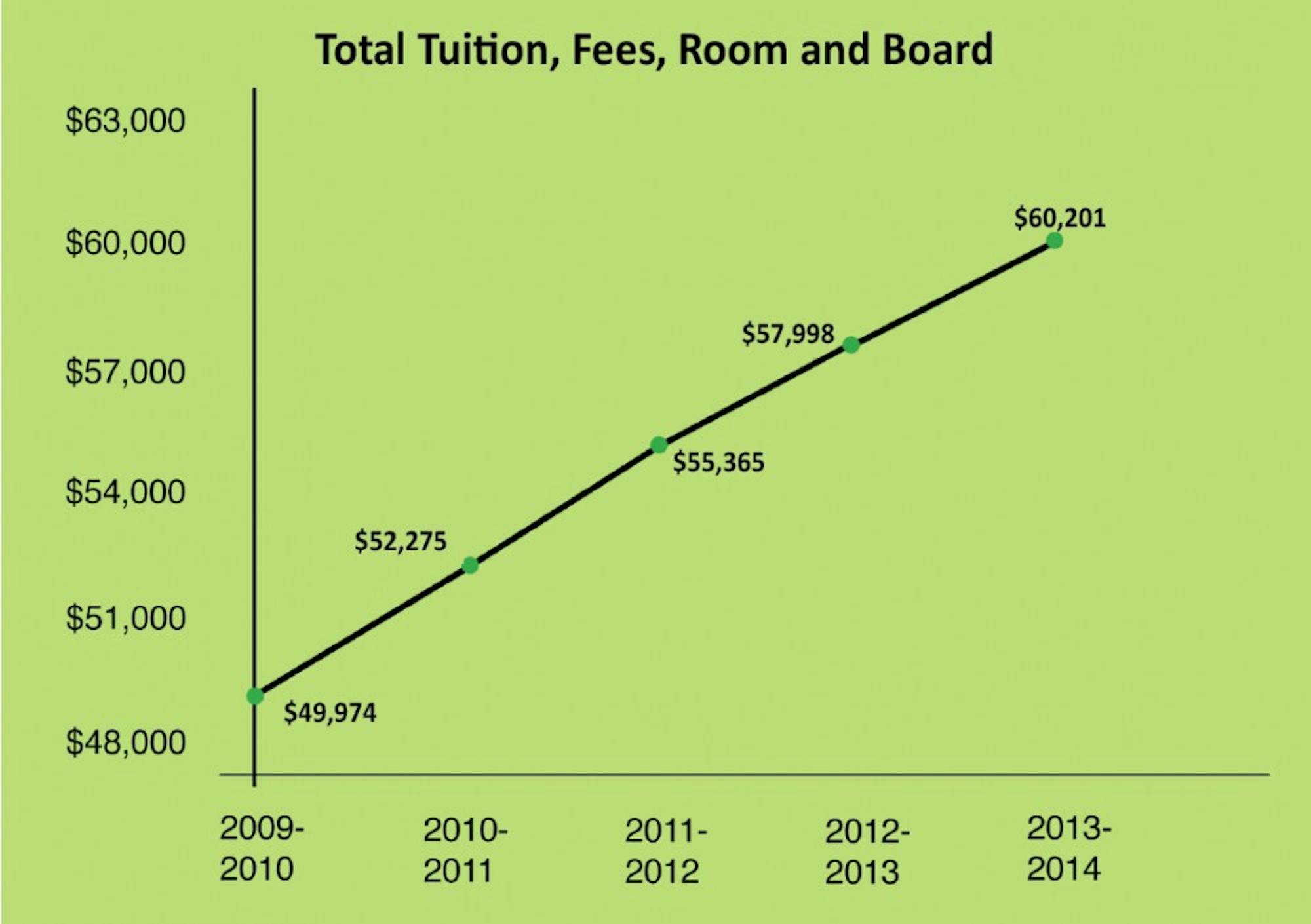Although the College will not finalize its 2014-15 tuition amount until later this month, national trends point toward an ever-rising cost of attendance. With a sticker price of $63,282, Dartmouth was the second-most expensive Ivy League university in the 2013-14 academic year, following Columbia University.
Between 2009 and 2014, Dartmouth’s tuition and fees have increased an average of 4.8 percent per year. The 2013-14 year marked the lowest increase from the previous year’s tuition and fees, at 3.8 percent.
In an address to the faculty last fall, College President Phil Hanlon said that, in an effort to slow the rising cost of higher education, he would keep the College’s tuition rate flat with inflation.
Several higher education experts pointed toward administrative bloat and shifting university priorities as prominent reasons for the likely increase.
Benjamin Ginsberg, author of “The Fall of the Faculty: The Rise of the All-Administrative University and Why it Matters,” said that more active fundraising efforts at universities have allowed administrators to raise their salaries and hire more administrators, thus leading to tuition increases.
Ginsberg said that college costs nationwide have increased around 40 percent over the past 30 years, owing largely to increased administrative costs and new student services from wellness centers to bowling alleys.
According to the College Fact Book, total staff decreased from 3,417 to 3,175 between 2008 and 2011, the most recent data available. Meanwhile, the number of executive, administrative and managerial positions fluctuated, overall decreasing slightly from 330 to 327.
“In truth, your administration is about 33 percent larger than in the 1980s, and I don’t believe Dartmouth was a bad school in the 1980s,” Ginsberg said. “In fact, I recall that it was quite an excellent school, even though it didn’t have as many deans or ‘deanlettes.’”
Richard Vedder, director of the Center for College Affordability and Productivity, said that while faculty salaries are growing at approximately the same rate as those of other professional occupations, senior administrators have often seen “abrupt explosions of salaries.” He predicted that most universities will increase tuition by about 4 percent for the coming year.
“The basic problem is that there are virtually no incentives to keep costs down,” Vedder said. “There are many positive benefits to it — you can raise more money, hire more assistants, university presidents get a big hunk of money, keep alumni happy, keep students happy.”
According to the College’s financial statements for the 2013 fiscal year, Dartmouth’s annual operating expenses amounted to $835,273,000. Salaries and wages accounted for the bulk of expenditures at $350,991,000, with employee benefits totaling $124,583,000. The two categories combined accounted for nearly 57 percent of annual expenses.
Meanwhile, the College received $833,491,000 in revenues. Net tuition and fees accounted for 21.7 percent of revenues at $180,585,000.
Unlike the 2012 fiscal year, when the College’s revenues exceeded its expenses, Dartmouth’s recent expenses have exceeded its revenue. At the same time, total tuition and fees increased by 8.7 percent, from around $55,365 for the 2011-12 academic year to $60,201 for the 2013-14 year.
While tuition trends are similar across the country, experts said that Dartmouth and its peer institutions have more leeway in terms of raising their prices because there are more than enough students who are willing to pay.
Ginsberg said that continually rising prices intimidate a growing number of prospective students.
Vedder suggested that the College’s 14 percent drop in applications for the 2014-15 academic year may introduce real incentives for Dartmouth to change its pattern of raising tuition.
“If you had asked me [about tuition trends at Dartmouth and its peer institutions] before I heard about the Dartmouth application decline, until recently the trend has been that elite schools have been able to get away with murder, because their application numbers keep rising,” Vedder said.
Andrew Gillen, an education researcher at the American Institutes of Research, said that universities may be reaching the end of an “automatically increase tuition all the time”-strategy, citing the fact that several nonprofit schools have been freezing or lowering tuition.
Families who have traditionally chosen to send their children to expensive private universities have begun to look toward state schools as less expensive alternatives, he said, though he noted that the rate at which state school tuition has increased is actually higher.
Several Ivy League universities have released their cost of attendance numbers for the 2014-15 academic year. Princeton University will increase its total cost by 4.1 percent to $58,965, while the University of Pennsylvania will increase its tuition and fees by 3.9 percent to $61,132, exceeding $60,000 for the first time.
Other Ivy League schools have yet to release 2014-15 tuition amounts.




